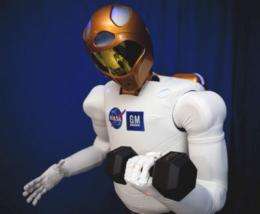NASA to Launch Robonaut 2 Robot to International Space Station


(PhysOrg.com) -- NASA will launch the first human-like robot to space later this year to become a permanent resident of the International Space Station. Robonaut 2, or R2, was developed jointly by NASA and General Motors under a cooperative agreement to develop a robotic assistant that can work alongside humans, whether they be astronauts in space or workers at GM manufacturing plants on Earth.
The 300-pound Robonaut 2 consists of a head and a torso with two arms and two hands and will launch on space shuttle Discovery as part of the STS-133 mission planned for September. Once aboard the station, engineers will monitor how the robot operates in weightlessness. R2 joins another station robot, known as Dextre. That robot, built by the Canadian Space Agency, consists of two, long arms to perform tasks that normally require spacewalking astronauts to complete.
While Dextre is located on the station's exterior, R2 will be confined to operations in the station's Destiny laboratory. However, future enhancements could allow it to move more freely around the station's interior, and it could one day be modified to operate outside the complex.
“The use of R2 on the space station is just the beginning of a quickening pace between human and robotic exploration of space,” said John Olson, director of NASA's Exploration Systems Integration Office. “The partnership of humans and robots will be critical to opening up the solar system and will allow us to go farther and achieve more than we can probably even imagine today.”
The dexterous humanoid robot not only looks like a human, it is designed to work like one. With human-like hands and arms, R2 is able to use the same tools that station crew members use. In the future, the greatest benefit of humanoid robots in space may be as an assistant or stand-in for astronauts during spacewalks or for tasks too difficult or dangerous for humans. For now, R2 is still a prototype and lacks adequate protection needed to exist outside the space station in the extreme temperatures of space.
Testing the robot inside the station will provide an important intermediate environment. R2 will be tested in zero gravity, as well as being subjected to the station’s radiation and electromagnetic interference environments. The interior operations will provide performance data on how a robot may work side-by-side with astronauts. As development activities progress on the ground, station crews may be provided hardware and software to update R2 to allow it to do new tasks.
R2 is undergoing extensive testing in preparation for its flight. Vibration, vacuum and radiation testing along with other procedures being conducted on R2 also benefit the team at GM. The automaker plans to use technologies from R2 in future advanced vehicle safety systems and manufacturing plant applications.
“The extreme levels of testing R2 has undergone as it prepares to venture to the International Space Station are on par with the validation our vehicles and components go through on the path to production,” said Alan Taub, vice president of GM’s global research and development. “The work done by GM and NASA engineers also will help us validate manufacturing technologies that will improve the health and safety of our GM team members at our manufacturing plants throughout the world.”
GM’s manufacturing engineering team is already working to identify potential applications for R2’s array of vision, motion and sensor technologies that will assist workers in manufacturing operations.
Provided by General Motors




















